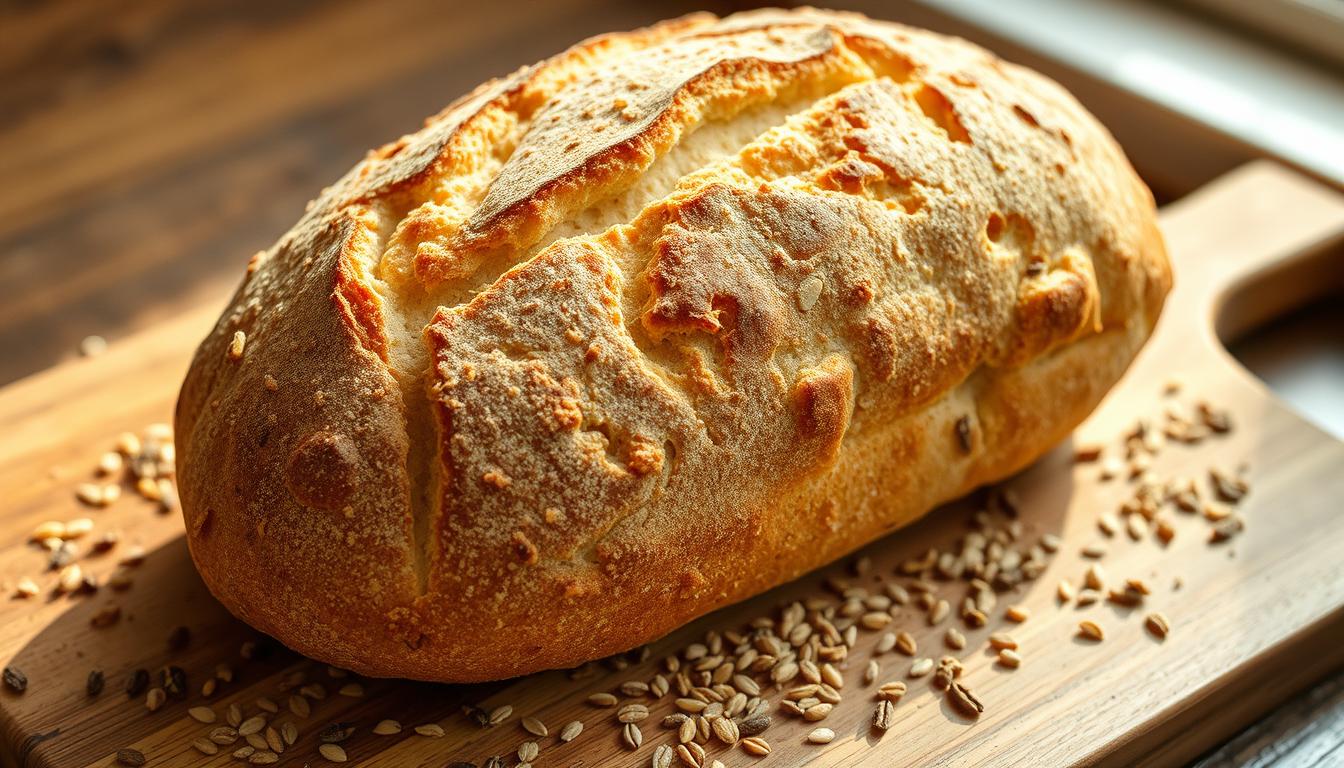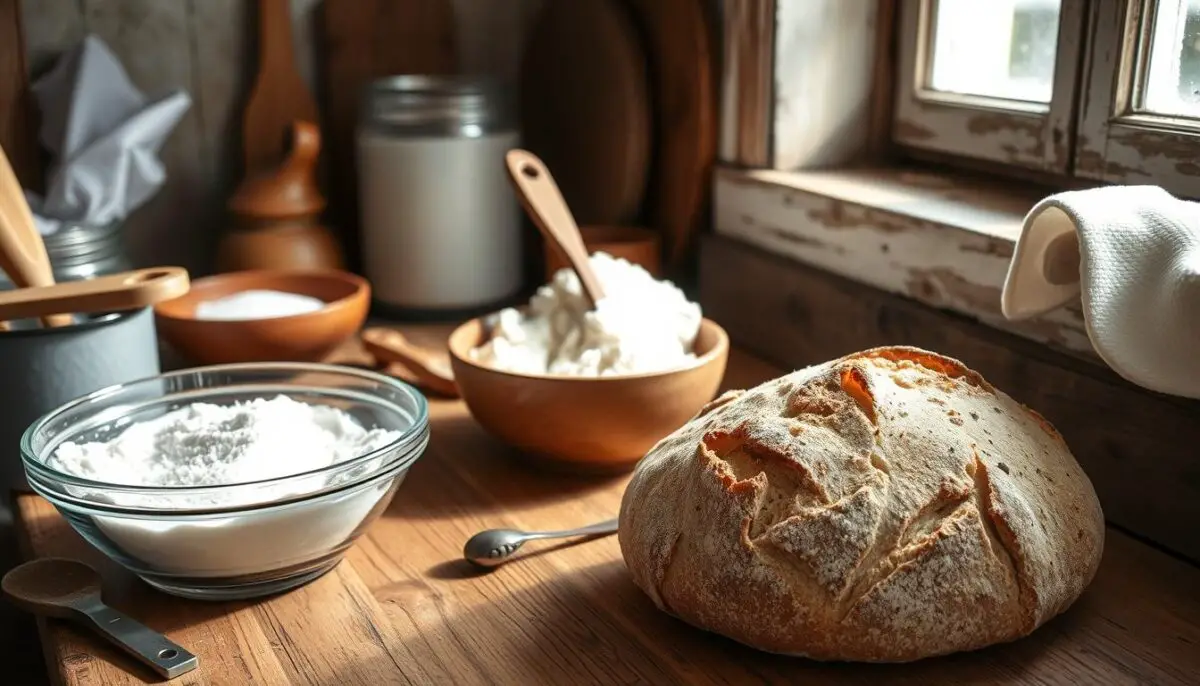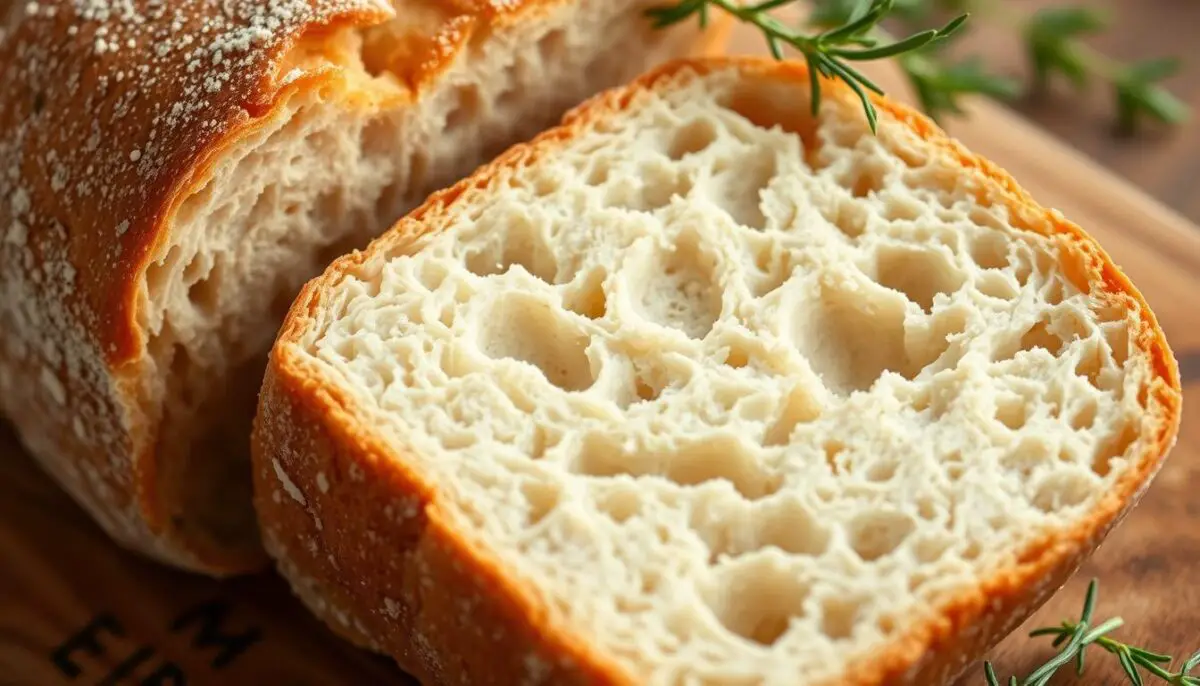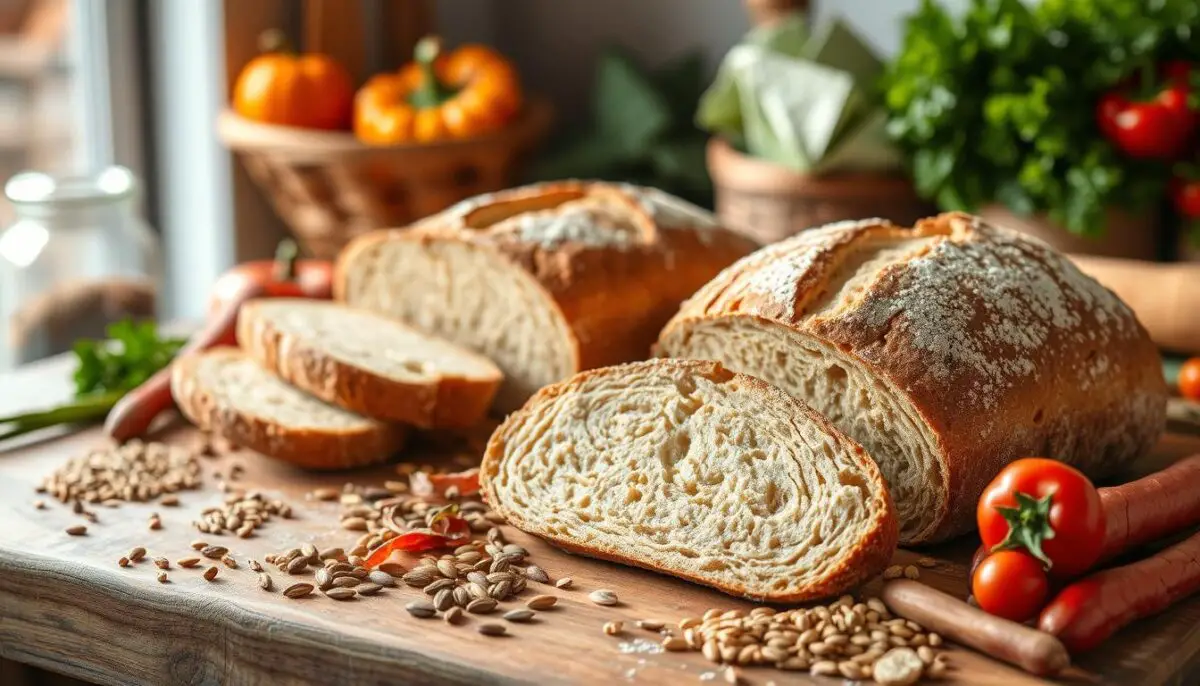Gluten-free sourdough bread is a great choice for those who can’t eat gluten. It has the same rich flavors and textures as traditional bread. This bread uses wild yeast and beneficial bacteria, making it a healthy option.
It has a special sourdough starter that captures these natural elements. This allows people to enjoy their favorite bread without the bad effects of gluten.
Key Takeaways
- Gluten-free sourdough utilizes a special starter made from wild yeast and bacteria.
- This type of bread provides a delicious, nutritious alternative for gluten-sensitive individuals.
- Proper measurements and ingredient selections are key for the best results in gluten-free baking.
- Using a Dutch oven helps keep steam in and improves the bread’s texture during baking.
- Fermentation and proofing times are longer than traditional yeast breads, so patience is needed.
Introduction to Gluten Free Sourdough Bread
More people are looking into gluten-free diets because of celiac disease and gluten intolerance. They want food that tastes good and is healthy. Gluten-free sourdough bread is a great choice because it tastes and feels like real bread.
Gluten-free sourdough is made differently than other gluten-free bread. It uses a special starter that ferments for 12-14 hours. This makes the bread taste better and adds good bacteria.
The dough for gluten-free sourdough is thick, like brownie batter. This means you don’t have to knead it. It’s easy for beginners to make. Plus, it proofs quickly, in just 1-2 hours.
Gluten-free sourdough is delicious and chewy. It’s a great choice for any meal. Making it at home can be rewarding and healthier than store-bought bread. Trying gluten-free sourdough can make your diet more exciting and healthy.
What is Gluten Free Sourdough Bread?
Gluten-free sourdough bread is special because of its baking method. It uses a sourdough starter with wild yeast and bacteria. This makes the bread taste unique and is easier to digest, great for those with gluten issues.
Understanding the Characteristics of Sourdough
The flavor of sourdough is tangy but milder in gluten-free versions. The fermentation process creates this taste and a chewy texture. The dough rests for 20 minutes and rises for 2 1/2 to 4 hours, making it very puffy.
The Importance of Wild Yeast and Bacteria
Wild yeast is key in sourdough. It works with beneficial bacteria to break down carbs and phytic acid. This makes nutrients easier to absorb. Gluten-free sourdough is safer for those with celiac disease or gluten intolerance.
| Process Stage | Details |
|---|---|
| Resting Time | 20 minutes for flour hydration and dough stiffening |
| Rising Time | 2 1/2 to 4 hours until dough is very puffy |
| Baking Temperature | Preheat oven to 500°F for at least 45 minutes |
| Baking Duration | 45 to 50 minutes at 450°F |
| Optimal Internal Temperature | Reach 209°F for well-baked bread |
| Storage | Room temperature for 2 to 3 days; refrigerate for 16 to 24 hours |
Benefits of Gluten Free Sourdough Bread
Gluten-free sourdough bread is great for those on a gluten-free diet. It’s not just tasty; it’s also good for your health. Let’s explore the nutritional and digestive perks of eating this bread.
Nutritional Advantages
Gluten-free sourdough has more nutrients than regular bread. The fermentation process makes vitamins and minerals like B vitamins, iron, and zinc easier to absorb. This means your body gets more out of what you eat.
It also has less phytic acid. This is good because phytic acid can block nutrient absorption. So, sourdough is a great choice for those looking to get the most nutrients from their food.
Digestive Benefits from Fermentation
The way sourdough is made helps your digestion. It’s full of probiotics that help your body digest food better. These probiotics also help you absorb nutrients more efficiently.
Plus, sourdough has less FODMAPs, which can be hard to digest. This makes it easier for people with gluten intolerance to eat. They can handle sourdough better because it has less gluten and fructan.
Creating Your Gluten Free Sourdough Starter
Starting a gluten-free sourdough starter needs careful attention. This includes choosing the right flour and feeding it regularly. The flour you pick is key to growing the yeast and bacteria needed for fermentation.
Choosing the Right Flour for Your Starter
Choosing the right flour is important for a gluten-free starter. Use wholegrain flours like:
- Sorghum
- Brown rice
- Millet
- Buckwheat
- Amaranth
- Teff
Start with a wholegrain flour like sorghum. It often shows activity in just two days. As your starter matures, try mixing different flours. This can make it taste and feel better.
Feeding and Maintaining Your Starter
Keeping your gluten-free starter healthy is key. Feed it regularly by mixing:
| Day | Flour (grams) | Water (grams) |
|---|---|---|
| 2 | 30 | 40 |
| 5 | 30 | 40 |
| 6 | 30 | 40 |
| 8 | 30 | 40 |
| 9 | 30 | 40 |
Feed your starter daily if it’s at room temperature. Or feed it weekly if it’s in the fridge. Tap water is fine, but let it sit out overnight to remove chlorine. If you see liquid on top, it’s time to feed it again.
Using less flour and water for maintenance is easier than traditional methods. Watch your starter closely and feed it right. This way, you’ll have a healthy gluten-free sourdough starter for baking.
Essential Ingredients for Gluten Free Sourdough Bread
Making gluten-free sourdough bread needs careful picking of ingredients. It’s key to choose the right gluten-free flours for the perfect texture and taste. Each flour adds something special to the dough.
Adding psyllium husk is also vital. It helps the dough have structure and stretchiness, like regular bread. This part talks about the must-have ingredients for gluten-free sourdough baking.
Flours to Use: Recommendations and Tips
For gluten-free flours, mixing different types is best. Here are some top picks:
- Brown Rice Flour: It has a mild taste and a light feel.
- Sorghum Flour: It adds a sweet hint and boosts moisture.
- Tapioca Starch: It makes the bread chewy and helps it stick together.
- King Arthur’s Gluten-Free Measure for Measure Flour: It’s great for consistent results, acting like regular flour.
Different flours can change the bread’s texture. For example, mixing buckwheat flour with King Arthur’s flour can lead to great results.
Utilizing Psyllium Husk for Structure
Psyllium husk is a must for gluten-free sourdough. It helps the dough stick together and keeps moisture in. About 20g is usually the right amount.
When using psyllium husk, try different ratios with your flour mix. Making these tweaks can greatly enhance your gluten-free sourdough’s quality and texture.
Step-by-Step Guide to Making Gluten Free Sourdough Bread
Making gluten-free sourdough bread is a fun process. It starts with mixing your ingredients right. This makes a dough that ferments well. Follow these steps to get better at gluten-free baking.
Mixing Your Ingredients
First, make your gluten-free sourdough starter. You’ll need:
- Day 1: 50 grams of whole grain flour and 60 grams of water
- Day 2: 30 grams of whole grain flour and 40 grams of water
- Days 3 and 4: Repeat the same feeding routine as Day 2
- Day 5: Discard half of the starter and feed the remainder with 30 grams of flour and 40 grams of water
Watch for bubbles, expansion, and a sour smell by Day 10. These signs mean your starter is ready for the fridge.
Fermentation and Proofing Process
For the main recipe, use 110 grams of starter. Mix it with 450 grams of flour. This includes brown rice, millet, sorghum, and buckwheat. Add 3 tablespoons of psyllium husk and 10 grams of salt. Use 1.5 to 2 cups of lukewarm water to get the right dough.
For sweetness, add a tablespoon of honey. Let the dough ferment in a warm place, 70-80 degrees Fahrenheit. Use a thermometer to check the temperature. After proofing, the dough will be ready to bake, making a tasty gluten-free bread.
| Ingredient | Amount |
|---|---|
| Whole Grain Flour (Day 1) | 50 grams |
| Water (Day 1) | 60 grams |
| Whole Grain Flour (Day 2) | 30 grams |
| Water (Day 2) | 40 grams |
| Total Flour | 450 grams |
| Psyllium Husk | 3 tablespoons |
| Salt | 10 grams |
| Lukewarm Water | 1.5 to 2 cups |
| Honey (Optional) | 1 tablespoon |
Gluten Free Sourdough Bread vs Traditional Bread
Gluten-free sourdough bread and traditional sourdough have big differences. Traditional sourdough is known for its chewy texture and airy crumb. This comes from gluten. Gluten-free bread, on the other hand, uses different flours and psyllium husk to get close to this texture.
The taste of these two breads is also different. This is because of the gluten in traditional sourdough. Gluten-free sourdough has a unique taste that is often milder.
Texture and Flavor Differences
Traditional sourdough is famous for its chewy texture. This is thanks to gluten. Gluten-free sourdough tries to match this with a mix of flours and psyllium husk. But, it might not have the same airy crumb as traditional sourdough.
The taste of gluten-free sourdough is unique. It’s often softer and less tangy than traditional sourdough. Both types of bread benefit from fermentation, which makes them taste better and easier to digest. Gluten-free sourdough is a tasty option for those who can’t eat gluten.
| Characteristic | Traditional Sourdough | Gluten-Free Sourdough |
|---|---|---|
| Texture | Chewy with an airy crumb | Soft but denser, with varying chewiness |
| Main Ingredient | Wheat flour | Alternative flours (e.g., rice, almond) |
| Gluten Content | Upwards of 200 ppm | Less than 20 ppm (gluten-free) |
| Flavor | Rich, tangy flavor | Subtly different, often milder |
| Fermentation Benefits | Enhances digestibility, lowers anti-nutrients | Similar benefits, though varies by flour type |
Common Challenges when Baking Gluten Free Sourdough Bread
Baking gluten-free sourdough bread comes with its own set of challenges. Home bakers often face problems with dough management and fermentation. Knowing these challenges can help you solve them and bake a great loaf.
Addressing Dough Stickiness
Dough stickiness is a big problem with gluten-free flours. These flours can make the dough wet and hard to work with. Here are some tips to fix this:
- Increase the flour slowly while mixing.
- Use less liquid to adjust the dough’s moisture.
- Let the dough rest to soak up moisture.
Adding psyllium husk flakes can also help. They make the dough firmer and easier to handle.
Dealing with Rising Issues
Insufficient rising is a common issue, often due to an inactive starter. To help yeast grow, create the right environment. Here are some tips for a good rise:
- Feed your starter regularly, every 12 hours, to keep yeast healthy.
- Keep the fermentation area at 70-75 degrees Fahrenheit.
- Look for signs of activity like bubbles and a nice smell during proofing.
Using non-chlorinated water is also important. It helps yeast grow better. A good environment for fermentation can greatly reduce rising problems.
Tools and Equipment for Successful Baking
To make a perfect gluten-free sourdough loaf, you need the right tools and equipment. Using the right sourdough essentials can really improve your baking. From precise measurements to the best baking conditions, these tools will make your baking better.
Must-Have Kitchen Tools
For a delicious gluten-free sourdough bread, you’ll need these tools:
- Digital Scale – Accurate measurements are key in sourdough baking. A digital scale helps you get the right ingredient ratios, which affects the bread’s texture and flavor.
- Stand Mixer – A stand mixer mixes ingredients well, which is important for gluten-free doughs that can be sticky.
- Dutch Oven – This equipment creates a perfect baking environment. It gives a crispy crust and a soft inside, thanks to the steam it produces.
- Banneton – A banneton helps your dough rise properly and keeps its shape. It also makes the crust look beautiful.
- Razor Blade – For making cuts in the dough, a razor blade is best. It makes clean cuts that look good and help the bread expand right.
Importance of Using a Digital Scale
A digital scale is a small investment that makes a big difference. It helps you measure ingredients accurately, which is very important in gluten-free baking. Expect to spend less than $10 on it. Accurate measurements lead to a better rise, texture, and flavor in your sourdough bread.
Using these tools and equipment will change your gluten-free sourdough baking. With the right tools, making a great loaf is easier and more fun.
| Tool | Purpose | Benefits |
|---|---|---|
| Digital Scale | Measuring ingredients | Precision and consistency in baking |
| Stand Mixer | Mixing batter | Thorough mixing for better texture |
| Dutch Oven | Baking | Creates a steamy environment for crust |
| Banneton | Proofing dough | Helps maintain shape and adds design |
| Razor Blade | Slashing dough | Controls expansion and adds aesthetic appeal |
Creative Ways to Use Your Gluten Free Sourdough Bread
Gluten-free sourdough bread is a blank canvas for endless culinary ideas. It adds unique flavors and textures to your meals. Use it in sandwiches and toast to explore a world of gluten-free recipes. It’s perfect for breakfast, lunch, or a tasty snack.
Recipes for Sandwiches and Toast
Start your day with sourdough toast. Top it with avocado and salt for a healthy breakfast. For lunch, try a grilled cheese on gluten-free sourdough. Add roasted veggies or turkey for a gourmet twist.
If you’re short on time, make a gluten-free sourdough pizza crust in just ten minutes. It’s a fun twist for weeknight dinners.
Pairing Suggestions for Flavor Enhancements
Get creative with spreads and toppings for your gluten-free sourdough. Try roasted garlic and rosemary for a savory taste. For something sweet, use fruit preserves or honey on your toast.
Experiment with different flavors to enjoy your sourdough. Use your sourdough discard to make gluten-free crackers or scones. This way, you can reduce kitchen waste and have fun with baking.
Let your imagination run wild with these baking ideas. Gluten-free sourdough bread is a delightful staple for any meal. Try making everything from chocolate chip cookies to savory scones.
Storing and Reheating Your Gluten Free Sourdough Bread
Storing gluten-free sourdough bread right keeps it tasty and fresh. With the right methods, you can enjoy your sourdough longer. This makes all your baking work worth it.
Best Practices for Storage
Here are some tips to keep your gluten-free sourdough bread fresh:
- Wrap the bread in a clean cloth and place it in a bread box to allow for air circulation.
- Store the bread in an airtight container on the counter after thawing, ensuring it lasts for 3 to 5 days in a cool kitchen.
- For long-term preservation, freeze the bread. Sourdough can be kept in the freezer for 4 to 8 weeks without losing its flavor.
- Pre-slicing your sourdough and freezing it allows for convenience and ease when you need a quick snack.
- Uncut whole loaves also freeze well, resembling the qualities of freshly baked bread when reheated.
How to Reheat for Optimal Freshness
Reheating gluten-free sourdough bread right brings back its moisture and texture. Here are some reheating tips:
- For the best results, use a pre-heated oven. Baking the bread at 350°F for about 8 to 15 minutes restores warmth and crispness.
- Alternately, grilling at 350°F for about 4 minutes can enhance the flavor.
- To toast individual slices, use a microwave for about 20 seconds with the Bagel setting. This refreshes the taste without too much moisture.
- A frozen sourdough loaf can defrost inside a ziplock bag at room temperature, typically taking around three hours.
Conclusion
Gluten-free sourdough bread is not just tasty. It also comes with many sourdough benefits. It’s full of vitamins B1 to B6, magnesium, and iron. This makes it great for your health, even if you’re gluten sensitive.
The way it’s made also helps control blood sugar. This is good for anyone watching their health. It’s a smart choice for those who care about their diet.
Making gluten-free sourdough is easy and fun. With the Free Gluten-Free Sourdough Starter Course, you can start baking in just eight days. Once you have a starter, keeping it going is simple. This makes baking a breeze for anyone.
Adding gluten-free sourdough to your meals can make a big difference. It can help with digestion and balance your nutrition. It’s a tasty and healthier option compared to regular bread.
So, if you’re thinking about trying gluten-free baking, go for it. You’ll find amazing flavors and healthier options. Plus, you’ll enjoy making your own bread at home.
FAQ
What’s the difference between gluten-free sourdough and regular gluten-free bread?
Gluten-free sourdough has a tangy taste and a chewy texture. This is thanks to its natural fermentation. Most gluten-free breads don’t have this depth of flavor and texture. So, gluten-free sourdough is a better choice for those who can’t eat gluten.
How does fermentation enhance the health benefits of gluten-free sourdough?
The fermentation in gluten-free sourdough makes it easier to digest. It also creates good bacteria in the gut. This improves digestion and helps the body absorb nutrients better. So, it’s a healthier option for those on a gluten-free diet.
What flours are best for creating a gluten-free sourdough starter?
For a gluten-free sourdough starter, use brown rice flour, sorghum flour, and millet flour. These flours give the starter the nutrients it needs to grow wild yeast and good bacteria.
Can I use any kitchen equipment for making gluten-free sourdough bread?
You can use general kitchen tools to make gluten-free sourdough bread. But, tools like a digital kitchen scale, a stand mixer, and a Dutch oven can really help. They make the baking process easier and better.
What is the ideal way to store gluten-free sourdough bread?
To keep gluten-free sourdough bread fresh, wrap it in cloth and store it in a bread box. Or, use a resealable bag. Make sure it’s dry to avoid mold.
How can I troubleshoot common issues in gluten-free sourdough baking?
If your dough is too sticky, try changing the flour ratio or adding a bit more water. If it’s not rising, check your starter’s activity. Also, make sure it’s in the right conditions for fermentation.
Are there any health benefits associated with gluten-free sourdough bread?
Yes, gluten-free sourdough is rich in fiber. It also supports digestive health because of its fermentation. It’s a great choice for a healthy diet.




